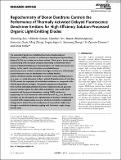Files in this item
Regiochemistry of donor dendrons controls the performance of thermally activated delayed fluorescence dendrimer emitters for high efficiency solution-processed organic light-emitting diodes
Item metadata
| dc.contributor.author | Sun, Dianming | |
| dc.contributor.author | Saxena, Rishabh | |
| dc.contributor.author | Fan, Xiaochun | |
| dc.contributor.author | Athanasopoulos, Stavros | |
| dc.contributor.author | Duda, Eimantas | |
| dc.contributor.author | Zhang, Ming | |
| dc.contributor.author | Bagnich, Sergey | |
| dc.contributor.author | Zhang, Xiao-Hong | |
| dc.contributor.author | Zysman-Colman, Eli | |
| dc.contributor.author | Koehler, Ann | |
| dc.date.accessioned | 2022-04-26T15:30:03Z | |
| dc.date.available | 2022-04-26T15:30:03Z | |
| dc.date.issued | 2022-07-15 | |
| dc.identifier | 278686637 | |
| dc.identifier | a672af23-0c9a-4fe1-85cc-a2610eb1a409 | |
| dc.identifier | 000787023000001 | |
| dc.identifier | 85128739613 | |
| dc.identifier.citation | Sun , D , Saxena , R , Fan , X , Athanasopoulos , S , Duda , E , Zhang , M , Bagnich , S , Zhang , X-H , Zysman-Colman , E & Koehler , A 2022 , ' Regiochemistry of donor dendrons controls the performance of thermally activated delayed fluorescence dendrimer emitters for high efficiency solution-processed organic light-emitting diodes ' , Advanced Science , vol. 9 , no. 20 , 2201470 . https://doi.org/10.1002/advs.202201470 | en |
| dc.identifier.issn | 2198-3844 | |
| dc.identifier.other | ORCID: /0000-0001-7183-6022/work/112333740 | |
| dc.identifier.uri | https://hdl.handle.net/10023/25247 | |
| dc.description | This work has received funding from the European Union's Horizon 2020 research and innovation programme under the Marie Skłodowska-Curie grant agreement No. 838009 (TSFP) and No 812872 (TADFlife). D.S. acknowledges support from the Marie Skłodowska-Curie Individual Fellowship, the National Postdoctoral Program for Innovative Talents (BX201700164), the Jiangsu Planned Projects for Postdoctoral Research Funds (2018K011A). E.Z.-C. is a Royal Society Leverhulme Trust Senior Research fellow (SRF∖R1∖201089). The St Andrews team would also like to thank the Leverhulme Trust (RPG-2016047) and EPSRC (EP/P010482/1) for financial support. This work was also supported by Comunidad de Madrid (Spain) – multiannual agreement with UC3M (“Excelencia para el Profesorado Universitario” – EPUC3M14) – Fifth regional research plan 2016-2020 and by the Spanish Ministry of Science, Innovation and Universities (MICINN) through project RTI2018-101020-B-100. X.Z. would like to thank the support from the National Key Research & Development Program of China (Grant No. 2020YFA0714601, 2020YFA0714604), the National Natural Science Foundation of China (Grant No. 52130304, 51821002), Suzhou Key Laboratory of Functional Nano & Soft Materials, Collaborative Innovation Center of Suzhou Nano Science & Technology, the Priority Academic Program Development of Jiangsu Higher Education Institutions (PAPD), the 111 Project, Joint International Research Laboratory of Carbon-Based Functional Materials and Devices. | en |
| dc.description.abstract | The potential of dendrimers exhibiting thermally activated delayed fluorescence (TADF) as emitters in solution-processed organic light-emitting diodes (OLEDs) has to date not yet been realized. This in part is due to a poor understanding of the structure–property relationship in dendrimers where reports of detailed photophysical characterization and mechanism studies are lacking. In this report, using absorption and solvatochromic photoluminescence studies in solution, the origin and character of the lowest excited electronic states in dendrimers with multiple dendritic electron-donating moieties connected to a central electron-withdrawing core via a para- or a meta-phenylene bridge is probed. Characterization of host-free OLEDs reveals the superiority of meta-linked dendrimers as compared to the already reported para-analogue. Comparative temperature-dependent time-resolved solid-state photoluminescence measurements and quantum chemical studies explore the effect of the substitution mode on the TADF properties and the reverse intersystem crossing (RISC) mechanism, respectively. For TADF dendrimers with similarly small ∆EST, it is observed that RISC can be enhanced by the regiochemistry of the donor dendrons due to control of the reorganization energies, which is a heretofore unexploited strategy that is distinct from the involvement of intermediate triplet states through a nonadiabatic (vibronic) coupling with the lowest singlet charge transfer state. | |
| dc.format.extent | 13 | |
| dc.format.extent | 5376293 | |
| dc.language.iso | eng | |
| dc.relation.ispartof | Advanced Science | en |
| dc.subject | TADF dendrimers | en |
| dc.subject | Triazine | en |
| dc.subject | Carbazole | en |
| dc.subject | External quantum efficiency | en |
| dc.subject | OLEDs | en |
| dc.subject | Solution-processing | en |
| dc.subject | QD Chemistry | en |
| dc.subject | DAS | en |
| dc.subject.lcc | QD | en |
| dc.title | Regiochemistry of donor dendrons controls the performance of thermally activated delayed fluorescence dendrimer emitters for high efficiency solution-processed organic light-emitting diodes | en |
| dc.type | Journal article | en |
| dc.contributor.sponsor | European Commission | en |
| dc.contributor.sponsor | European Commission | en |
| dc.contributor.sponsor | The Royal Society | en |
| dc.contributor.sponsor | The Leverhulme Trust | en |
| dc.contributor.sponsor | EPSRC | en |
| dc.contributor.institution | University of St Andrews. School of Chemistry | en |
| dc.contributor.institution | University of St Andrews. Centre for Energy Ethics | en |
| dc.contributor.institution | University of St Andrews. EaSTCHEM | en |
| dc.identifier.doi | 10.1002/advs.202201470 | |
| dc.description.status | Peer reviewed | en |
| dc.identifier.grantnumber | 838009 | en |
| dc.identifier.grantnumber | 812872 | en |
| dc.identifier.grantnumber | SRF\R1\201089 | en |
| dc.identifier.grantnumber | RPG-2016-047 | en |
| dc.identifier.grantnumber | EP/P010482/1 | en |
This item appears in the following Collection(s)
Items in the St Andrews Research Repository are protected by copyright, with all rights reserved, unless otherwise indicated.

